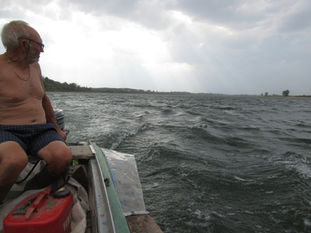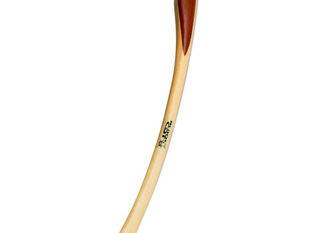
Living side-by-side with a jackal family comes at a cost. The obvious reason is that jackals do not like humans living close to their home. They want to be able to relax.
The granting of this simple wish comes with finding human-free spaces. Not an easy task these days. Humans are everywhere.
The stretch by the river is sufficiently far from villages, but during the summer there are the anglers and the camping enthusiasts. They, like the jackals, aim for secluded spots.
What helps is their weaknesses. Humans have many such but a main one is their love for luggage. They have to have much of that and don’t like carrying it around on their backs. Which means they need cars, and cars need roads.
So the jackals know: a nice place to spend a quiet day in is away from roads.
Another thing is water. Humans are afraid to drink from the river (which they themselves pollute in a horrible way). What they like best is a secluded place to which they can drive in their cars and there is a source of clean water close by.
My father’s camp at Km 727 is lacking two of these basic requirements: roads and drinking water. True, a dirt road gets improvised during the summer, but that is only during the low-water months: from mid-July on when the water-level gets below the 200 cm point.
Cars can go by that time, but there is no source of drinking water. Anglers could stop by for a week-end outing, but rarely over that. The camping-humans congregate in big families with children. They need a lot of clean water for drinking, cooking, and washing dishes. So, they prefer locations with spring-water and certainty about the road. Where, in case of a spell of rainy weather, or a suddenly rising water-level (which can happen even in August), they can easily load up their cars and haul their caravans to a higher place.
Keeping a camp at a waterless place, and with an appearing and disappearing dirt-road (more like a track on the gravelly bank), can be a first step towards having a jackal family for neighbours. The next steps involve gaining their trust by making food-sacrifices. Below we describe the long road before this is achieved.
On the road
The greatest challenge comes at the beginning: when all the luggage has to be carried from the family factory in Sofia, down to the fishing port of Stanevo, and then upriver to Km 727. Since the time is late April-early May, a dry sunny day is eagerly hunted for in the weather charts (Accuweather for Stanevo, Bulgaria, is the one preferred).
When the packed to the roof van leaves Sofia, it heads due North aiming to cross the Balkan Mountains by the pass of Petrokhan. The pass is a steep cut through the ridge, existing ever since the Roman legions crossed the mountain.

Down on the northern side of the ridge, the city of Montana is passed by on the left side of the motorway. From there on and all the way to Lom half-deserted villages are strung one after the other a few kilometres apart.
Then it is Lom. The city is not much different from days long past. The passenger boats are newer, of course, but no one gets on or off them: they are not for foreign tourists, not for the local people.


These are luxury floating hotels not used for local traffic. They stop for sightseeing at only two ports on the Bulgarian stretch of the river: Vidin and Rousse.
From the hill on the eastern side of the city the Danube is seen for the first time. How far the water stretches into the river port with its towering cranes gives a first idea about the water-level. At the sight, faint hopes of a dry track all the way to the future camp evaporate.
The next stop is at the big and prosperous village of Kovachitsa. This is the last chance for serious provisioning to last for the first two weeks or so. Ten litre plastic bottles of mineral water are put at every remaining still free place on the van, as well as canisters of petrol and propane-butane 20 l containers. That reaches the absolute limit.

From Kovachitsa it is only five kilometres to Stanevo. The mighty silos of the ‘agri-millionires’ (BOMAR Trade -the owners of the cow herd) are seen halfway to the village.

Once in Stanevo, a road-sign points to the vineyard near which the Vineyard Family are based (Post"Families and Territories"). A bumpy dirt-road leads to the guest-house - Villa Pomodiana, with the Pomodiana Family hiding nearby. Finally, the van drives down to the fishing port and stops a few metres from the river. The journey is over.
Now the luggage has to be carried upriver in boats. This is because the dirt-track is underwater which can be plainly seen from the port. The sight leaves no illusions that the van can proceed any further.

The ferrying is done with two boats. My father’s inflatable dinghy (Honda, 3.5 m) is pumped up first, let into the water, and the outboard installed (a 20 hp two-stroke Yamaha, since ’24 – a four-stroke 10 hp Honda). Then there is the long fishing boat of my father’s local friend and staunch supporter, Ivo Stanev. In two boats, all the equipment gets carried over the four kilometre upriver stretch to Km 727.
Four men are involved in the operation. These are my father and Ivo, and then the party from Sofia: my younger brother Bogdan, and his friend Radmil (Rado).
While three men are ferrying the luggage by the two boats upriver to Km 727, my father who has gone on the first trip receives the luggage from the incoming boats and stacks it higher up on the bank. In between these tasks, he also cuts all grass on what will be the ‘square’ or courtyard of the camp. This is a necessary operation easing movement and chasing out snakes. Regular cutting of the grass and the rapidly growing morfa bushes, as well as raking the area around the tent and carrying aside of all the weeds and twigs, needs to be done all through the season. The critical piece of equipment is a Husqvarna two-stroke grass-trimmer, as well as a set of garden tools.
In between these preparations, the camera-traps are set and the bait-site provided with the first dinner of the season. The menu is rich as befits a welcoming night: a kilo of meat on bones and a loaf of sliced bread. The big question now is: has the family survived the winter and the hunting season? Will they come in the evening?

All fears proved to be unfounded. When the cameras were downloaded next morning, it was seen that they had registered jackal movement practically as soon as they had been set: at 11:45 a.m.
Which could mean only one thing: the family had heard the boats coming and then unloading on the bank. They would have recognized my father’s voice and smell.
At 23:50 in the night, the first wailing call was heard. There was a single wail of two seconds, then a ua-ua; aua-aua ululation, and again a single wail of three seconds. The calling voice sounded like that of White Back – the Uncle. Maybe he was announcing to the others that the bait-site has opened.
That was the glorious end of the exhausting Day 1.






